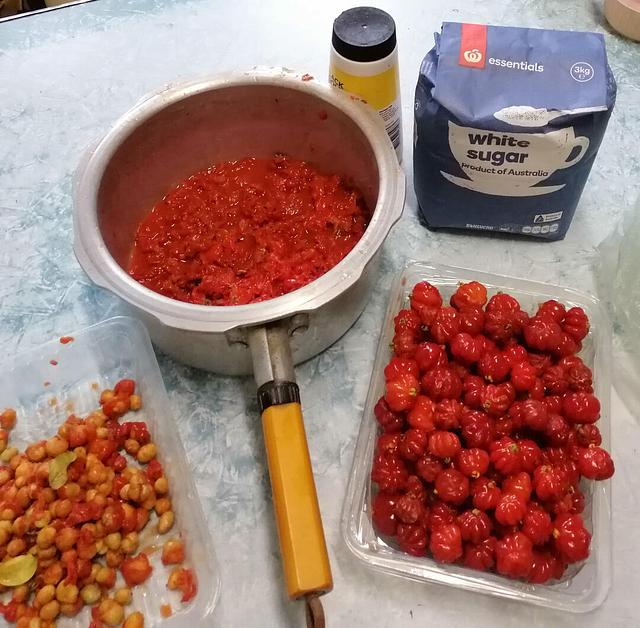Simple Pitanga Jam
It is a fruity season down-under. So, we make jams with our excesses.
Pitanga [Eugenia uniflora, also Suriname cherry, Brazilian cherry, Cayenne cherry, cerisier carré, monkimonki kersie and ñangapirí – depending on where your are ;-) ]
The basic ingredients for making jams are: fruits and heating ;-) Jam (jelly fruits) is a result of pectin (fibre compounds) binding to sugar (glucose) molecules in presence of some acids (molecule cleavers/splitters). Making jam is very much chemistry (like other cooking).
But some fruits do not have enough acids (to split sugar and pectin), so we add lemon juice (lime juice, makrut juice, vinegar would also do). Some fruits do not have enough fructose, so we add refined sugar. And some fruits do not have enough pectin fibre, we can add white pulp (below the peel) of ‘pomelo’, passionfruit pulp and peel, jackfruit rag (the white bits between yellow flesh sacks with seeds), apple,… any pectin rich fruits or parts of fruits.
We also add (sodium chloride) salt and lemon zest (grated lemon peel) and sometimes flowers, herbs and spices even seaweed for flavours and aromas.
It is also common to add in cheap ‘bulk’ pear, apple, choko, watermelon, passionfruit peel, jackfruit rag,… like to beef up (increase quantity of) jams.
How much of these do we use? Well Cooking is scientific experiments. We try and make notes. When we get it right, we make a discovery (urrrh, a recipe). We can then recalculate our cost and return/result of experiments and publish (like a good scientist or hide it under Intellectual Property -IP). 😊️
I have no doubt there are thousands of fruits in Thailand that we can make jam with. Perhaps community groups can use excess local produces to make new (hit tourists) products. (Have you tried ‘Sakura jam’ at about AUD 9.00 for a 100cc bottle? It's a jam but hold/without the fruit!)
I used a pressure cooking pot to save time and energy (20 minutes under pressure instead of hours of simmering). I also use a ‘stick blender’ to puree the cooked ingredients (also to save time in preparation and to make jam looks consistent - if your prefer chunky jam, don't blend). I use microwave oven to sterilize the (used/recycled) jam glass bottles (about 10 seconds per bottle without the lid. And I boil the lids separately for about 2 minutes. To put jam into bottles, will need care both bottles and jam are hot (we don't want you to get burns --absolutely care). Funnels can be handy --do sterilize funnels if you you use them. Cap the bottle immediately after filling and leave to cool down before labeling. This part is important for you and your customers . Your jam can stay on shelf for years if hygiene is observed.
OK. Jam is not your game. What about ‘namprik’ (chilli dip)? There will be a glut of freshwater fish (after the flood) and abundance of herbs and plant-base produces that can be blended in to make a varieties of namprik. And with scientific approaches (experiments) we can make new [online] products for [online] consumers and [international] tourists right in the community.
No cheating you hear!
ความเห็น (0)
ไม่มีความเห็น
